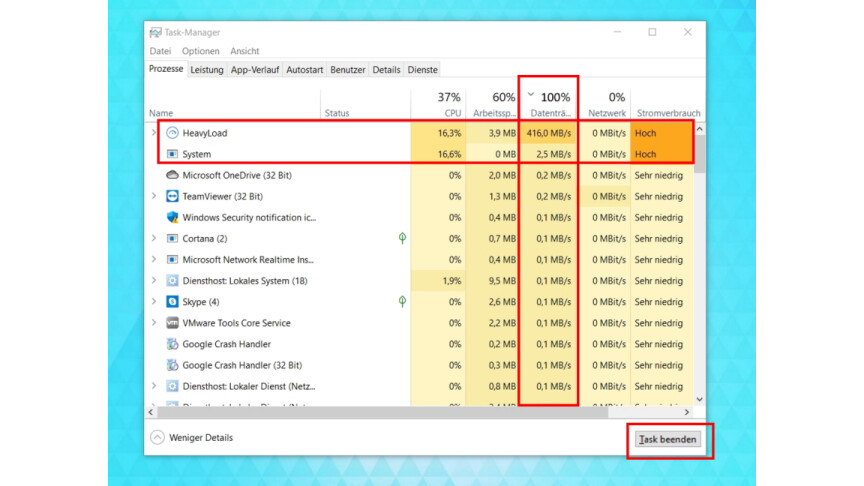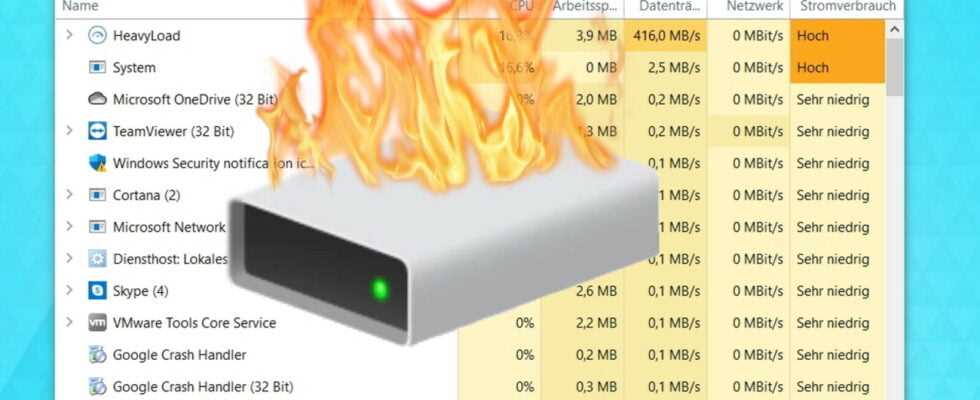On Windows 10 and Windows 11, a disk utilization of 100 percent should remain the absolute exception. With our tips you regulate the hard disk down again.
Step 1: Computer restart
- Step 2: Identify responsible task in Task Manager
Step 3: Clean startup programs
Step 4: Check / Turn off Windows indexing
Step 5: Check the anti-virus software
Step 6: Check hard drive and Windows for errors
Step 7: Update Windows or undo update
Under Windows 10 and Windows 11, the utilization of your system disk can sometimes increase to 100 percent. If the heavy load on your SSD or hard drive remains high for a long time without any apparent reason, you should find a remedy.
The data carrier should not be operated permanently under full load. On the one hand, this slows down all applications and slows down the loading and saving of data. On the other hand, the SSD or hard drive can heat up and be damaged.
Software problems, which can lead to crashes and data loss, are usually responsible for permanently high disk utilization. With our instructions you can get to the bottom of the problem step by step.
Please note: In this guide we use screenshots from Windows 10. However, the steps are the same on Windows 11 as only the window design has changed. The specified menus, key combinations and buttons are identical.
Step 1: Computer restart
Before you look for a cause, you should first restart your computer. If the high disk usage isn’t a permanent problem, it could already vanish into thin air.
Step 2: Identify responsible task in Task Manager

 1
1Opens with the keyboard shortcut CTRL + Shift key + ESC Open Task Manager and click “More Details” in the bottom left.

 2
2You then sort the “Disk” column in descending order to display the processes and applications responsible for the high disk usage. If a single app you know is responsible for this, you can terminate it, delete it, update it to a newer version or set it differently. You can use the “End task” button to throw the app(s) directly from the main memory. If several processes are responsible for the high utilization or you cannot identify the programs, you must continue.
Step 3: Clean startup programs
Over time, numerous programs started automatically with the computer accumulate on many computers, which then usually run unnoticed in the background. With the help of our instructions you can specifically check and remove the autostart programs.
Step 4: Check / Turn off Windows indexing
Windows file indexing running in the background, which scans your hard drive for new files at regular intervals to speed up the search function, can also be responsible for 100 percent disk utilization. In a separate guide, we will show you exactly what indexing is all about and how you can turn it on or off.
Step 5: Check the anti-virus software
Your antivirus software can also lead to a disk utilization of 100 percent through automatic system scans at regular intervals. Checks in the respective program settings whether any planned full system scans are responsible for this.
You can also try disabling the antivirus software briefly and see if that helps. You may want to switch to a different antivirus software. Our big comparison of the most important antivirus programs gives you a good overview.
Step 6: Check hard drive and Windows for errors
If the reason for the high drive utilization cannot be found at all, you should check the hard disk for errors using Chkdsk and the system files with the maintenance tools SFC and DISM. The three Windows tools can automatically detect and fix many problems.
Step 7: Update Windows or undo update
A Windows update might fix the high disk usage issue, but it could also be the culprit. Checks in the Windows settings whether a new update is available. If you only recently updated your PC and the problem has only occurred since then, you can undo a feature update or individual minor updates, depending on the case.
We have compiled solutions for other known errors in Windows 10 and problems under Windows 11 in the linked articles.
” Tip: The best VPN providers for more security and privacy
Don’t miss anything with the NETWORK-Newsletter
Every Friday: The most informative and entertaining summary from the world of technology!
